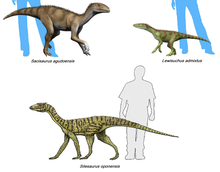Silesauridae
| Silesaurids Temporal range: ?Middle Triassic—Late Triassic, ?
| |
|---|---|

| |
| Scientific classification | |
| Kingdom: | Animalia |
| Phylum: | Chordata |
| Clade: | Dracohors |
| Family: | †Silesauridae Langer et al., 2010 |
| Subgroups | |
Silesauridae is an extinct family of Triassic dinosauriforms. It is most commonly considered to be a clade of non-dinosaur dinosauriforms, and the sister group of dinosaurs.[1][2][3][4][5] Some studies have instead suggested that most or all silesaurids comprised an early diverging clade or a paraphyletic grade within ornithischian dinosaurs.[6][7][8][9] Silesaurids have a consistent general body plan, with a fairly long neck and legs and possibly quadrupedal habits, but it is important to note that most silesaurids are heavily fragmentary nonetheless. Furthermore, they occupied a variety of ecological niches, with early silesaurids (such as Lewisuchus)[10] being carnivorous and later taxa (such as Kwanasaurus)[11] having adaptations for specialized herbivory. As indicated by the contents of referred coprolites, Silesaurus may have been insectivorous, feeding selectively on small beetles and other arthropods.[12]
Classification[]
Silesauridae is typically considered the sister group to Dinosauria. The group was named in 2010 by et al. They defined it as a branch-based clade of all archosaurs closer to Silesaurus opolensis than to either Heterodontosaurus tucki or Marasuchus lilloensis.[13] At around the same time, Sterling J. Nesbitt et al. (2010) independently named Silesauridae as a node-based clade consisting of Lewisuchus, Silesaurus, their last common ancestor and all their descendants.[1] Currently, both definitions encompass the same group of animals. Nesbitt et al. noted that the earlier definition by Langer et al. did not include a diagnosis, and so was not sufficient to create a ranked family-level name according to the ICZN. Therefore, the family Silesauridae is attributed to Nesbitt et al. (2010) while the clade Silesauridae is attributed to Langer et al. (2010).[3]
The fossils range in age from the Anisian to the Norian stages of the Triassic, about 245 to 203 million years ago.[1][13] The cladogram below follows the phylogenetic analysis of basal ornithodirans conducted by , Sterling Nesbitt and Neil Shubin (2012) with clade terminology from Cau (2018) and Martz and Small (2019).[3][5][14]
| Ornithodira |
| ||||||||||||||||||||||||||||||||||||||||||||||||||||||||||||||||||
A large phylogenetic analysis of early dinosaurs and dinosauromorphs carried out by Matthew Baron, David Norman and Paul Barrett (2017) and published in the journal Nature recovered Silesauridae as a monophyletic sister group to Dinosauria. The study also recovered the taxon Agnosphitys within the clade Silesauridae, close to Lewisuchus and its synonymous taxon Pseudolagosuchus.[4]
References[]
- ^ a b c Nesbitt, S.J.; ; Irmis, R.B.; Angielczyk, K.D.; Smith, R.M.H.; Tsuji, L.M.A. (2010). "Ecologically distinct dinosaurian sister group shows early diversification of Ornithodira". Nature. 464 (7285): 95–98. Bibcode:2010Natur.464...95N. doi:10.1038/nature08718. PMID 20203608.
- ^ Nesbitt, S.J. (2011). "The early evolution of archosaurs: relationships and the origin of major clades". Bulletin of the American Museum of Natural History. 352: 1–292. doi:10.1206/352.1. hdl:2246/6112.
- ^ a b c Kammerer, C. F.; Nesbitt, S. J.; Shubin, N. H. (2012). "The First Silesaurid Dinosauriform from the Late Triassic of Morocco" (PDF). Acta Palaeontologica Polonica. 57 (2): 277. doi:10.4202/app.2011.0015.
- ^ a b Baron, M.G.; Norman, D.B.; Barrett, P.M. (2017). "A new hypothesis of dinosaur relationships and early dinosaur evolution". Nature. 543 (7646): 501–506. doi:10.1038/nature21700. PMID 28332513.
- ^ a b Andrea Cau (2018). "The assembly of the avian body plan: a 160-million-year long process" (PDF). Bollettino della Società Paleontologica Italiana. 57 (1): 1–25. doi:10.4435/BSPI.2018.01.
- ^ Ferigolo, Jorge; Langer, Max C. (2007-01-01). "A Late Triassic dinosauriform from south Brazil and the origin of the ornithischian predentary bone". Historical Biology. 19 (1): 23–33. doi:10.1080/08912960600845767. ISSN 0891-2963.
- ^ Langer, Max C.; Ferigolo, Jorge (2013-01-01). "The Late Triassic dinosauromorph Sacisaurus agudoensis (Caturrita Formation; Rio Grande do Sul, Brazil): anatomy and affinities". Geological Society, London, Special Publications. 379 (1): 353–392. doi:10.1144/SP379.16. ISSN 0305-8719.
- ^ Cabreira, S.F.; Kellner, A.W.A.; Dias-da-Silva, S.; da Silva, L.R.; Bronzati, M.; de Almeida Marsola, J.C.; Müller, R.T.; de Souza Bittencourt, J.; Batista, B.J.; Raugust, T.; Carrilho, R.; Brodt, A.; Langer, M.C. (2016). "A Unique Late Triassic Dinosauromorph Assemblage Reveals Dinosaur Ancestral Anatomy and Diet". Current Biology. 26 (22): 3090–3095. doi:10.1016/j.cub.2016.09.040. PMID 27839975.
- ^ Müller, Rodrigo Temp; Garcia, Maurício Silva (2020-08-26). "A paraphyletic 'Silesauridae' as an alternative hypothesis for the initial radiation of ornithischian dinosaurs". Biology Letters. 16 (8): 20200417. doi:10.1098/rsbl.2020.0417. PMC 7480155.
- ^ Ezcurra, Martín D.; Nesbitt, Sterling J.; Fiorelli, Lucas E.; Desojo, Julia B. (24 August 2019). "New specimen sheds light on the anatomy and taxonomy of the early Late Triassic dinosauriforms from the Chañares Formation, NW Argentina". The Anatomical Record. 303 (5): 1393–1438. doi:10.1002/ar.24243. ISSN 1932-8494. PMID 31444989.
- ^ Martz, Jeffrey W.; Small, Bryan J. (2019-09-03). "Non-dinosaurian dinosauromorphs from the Chinle Formation (Upper Triassic) of the Eagle Basin, northern Colorado: Dromomeron romeri (Lagerpetidae) and a new taxon, Kwanasaurus williamparkeri (Silesauridae)". PeerJ. 7: e7551. doi:10.7717/peerj.7551. ISSN 2167-8359.
- ^ Martin Qvarnström; Joel Vikberg Wernström; Rafał Piechowski; Mateusz Tałanda; Per E. Ahlberg; Grzegorz Niedźwiedzki (2019). "Beetle-bearing coprolites possibly reveal the diet of a Late Triassic dinosauriform". Royal Society Open Science. 6 (3): Article ID 181042. doi:10.1098/rsos.181042. PMC 6458417. PMID 31031991.
- ^ a b Langer, M.C.; Ezcurra, M.D.; Bittencourt, J.S.; Novas, F.E. (2010). "The origin and early evolution of dinosaurs". Biological Reviews. 85 (1): 55–110. doi:10.1111/j.1469-185X.2009.00094.x. PMID 19895605.
- ^ Martz, J.W.; Small, B.J. (2019). "Non-dinosaurian dinosauromorphs from the Chinle Formation (Upper Triassic) of the Eagle Basin, northern Colorado: Dromomeron romeri (Lagerpetidae) and a new taxon, Kwanasaurus williamparkeri (Silesauridae)". PeerJ. 7: e7551. doi:10.7717/peerj.7551. PMC 6730537. PMID 31534843.
External links[]
- Silesauridae in the Paleobiology Database
- Silesaurids
- Prehistoric reptile families
- Anisian first appearances
- Rhaetian extinctions
- Dinosaur stubs
- Triassic reptile stubs

